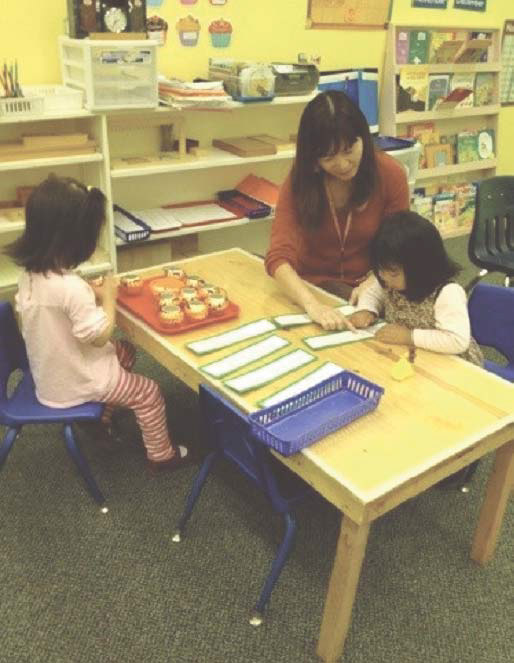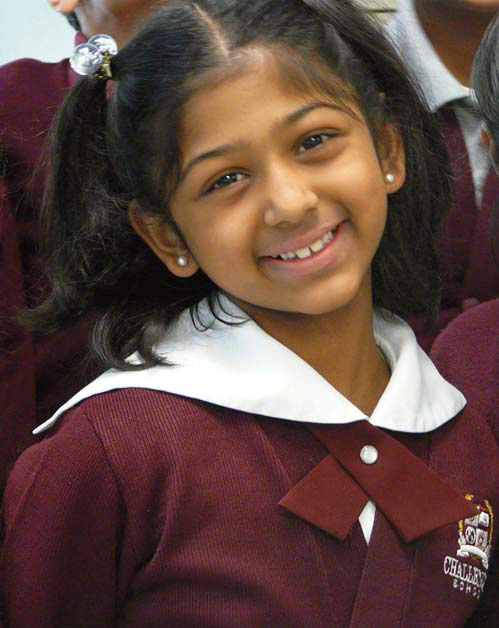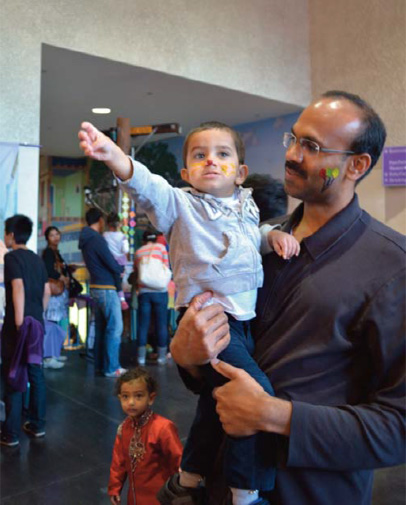When You Can’t wait for Kindergarten
IPM's Indepth Report!
When You Can't wait for Kindergarten
Why Asian-Indians prefer private pre-schooling
By Jo Ann Daugherty
Formal schooling in the United States begins at the age of five. But maybe you have a bright, inquisitive child who seems ready for schooling well before kindergarten. Or maybe you're concerned about the level of academics your child will be receiving in this country. For a variety of reasons, immigrant parents such as Indians and Asians are increasingly interested in starting their children's education in preschool.
Starting your child early on his road to academic success does not have universal support, and can engender mixed feelings in parents. Viswanth Rao of Auburn, California says he was undecided about the benefits of sending his daughter to preschool. On the one hand, "You can get a jump on education, since they're young, and being young it's easier to learn," he says. "But then, they're going to get it all eventually anyway, so why not start at five?"
Other parents may worry, if their child is extremely shy, that the group activity could be overwhelming to them. On the other hand, many times a child's shyness is exactly the motivation for preschool. If the child is cared for in a family setting, there is limited acces to other children, and the lack of socialization can be a concern. In a preschool, a child will learn how to take turns, share toys, eat, and perhaps nap in a group setting. If a family has recently immigrated to the United States and is still learning the language, preschool can be an excellent way for a child to become a proficient English speaker. Kim Vu of San Jose compared the experiences of her two children, on of whom attended preschool while the other did not; the difference in comprehension once the children started kindergarten was enormous.
Also parents seek reinforcement in lessons of decorum. Most preschools teach basic manners such as saying "please" and "thank you", picking up your toys, and getting along with others. Dr. Robert Schiirrmacher, a Program Director of Early Childhood Education at University of California, Santa Cruz, observes about Indian parenting that in general "being well-mannered is part of their value system." Carinda Henares agrees that in her experiences as a preschool teacher at Little Scholars, "Good behavior is very important to Indian parents."
By and large the motivation for preschooling a child seems to be academic. There is a widespread perception of American schools as being too lenient. Manjit Mahendran, teacher and mother of 5-year old Anureet, remembers having to get up in front of her first grade class in Punjab to recite multiplication tables up to 20 X 20, a feat that is nor required of American students until 3rd grade. A preschool that reminds Indian parents of their own shcooling can be highly attractive. And in a culture where marriage prospecs ats well as future career depends on academic success, the threat of an inadequate education can be a strong motivator to start young.
In America, where children have so many distractionsto contend with, such as telivision and peer pressure, enforcing good study habits can be difficult. But Indian parents have always had very strong feeligns about passing on cultural heritage, and an important aspect of this heritage is academic excellence.
Not all Indian parents are as intent on a strong academic emphasis during the preschool years. Dr Sudha Kahl professor of Childhood Education at San Jose State University, sent her 4- year-old son to a preschool that has very relaxed academic standards, though she admits that the rigorous standards in other preschools can be a big draw to Indians. "The parents themselves were in a system where there was competition and achievement was emphasized," she says. "It's bound to have an effect on their expectations for their own children."
Many parents claim that at three years of age their child is already outgrowing the education he/she may be receiving at home, and enjoys the enrichment that a preschool can bring to him. Tanya Lai, whose five-year old son attended Milpitas Montessori, says, "He learned his alphabet all by himself at two. He kept asking, "What does this mean?'" Tamara Nagley, Director of Little Scholars Elementary school in San Jose, says, "It's important to present the academics and motivate the children, because some are ready. It would be a shame no to give them the opportunity."
For a parent who considers their child ready, the choices available can be disorienting. The Bay Area offers a multitude of alternatives, only a few which are listed below.
MONTESSORI Milpitas Montessori School is part of a system that is available all over the world. Its founder, Dr. Maria Montessori, was born in Italy in 1870, educated as a pediatrician, and developed a system of education based on cultivating the child's natural curiosity about the world around him. She developed the educational system out of a concern about the rigid teaching techniques that were common at the time.
Though there are many "flavors" of Montessori philosophy available, certain tenets are common to the school system. The most unusual one is that there is no age segregation. One big room holds the entire preschool range of children 2 ½ to 6 years old.
There is very little structure to the curriculum; indeed, when one first steps inside the classroom the first impression can be one of barely restrained chaos. There are little knots of activity all over the area. Some bend over worksheets at a table. Some play on little mats on the floor. Others are helping themselves to juice and pretzels.
The basic philosophy behind the Montessori method is to let the child feel free to choose what they want to do; the structure is imposed on the environment more than on the child. Theteachers are trained to be guides and facilitators rather than instructors, to demonstrate the correct usage of materials that a child has expressed interest in. the ratio of teachers to students is 1:9.
Milpitas Montessori emphasizes that their school is not a preparation for kindergarten; however, the level of academic learning is very high. It is common for three and four year olds to spell out and read three letter words. In addition, the school teaches grammar, geography, and logic, all with the use of concrete, visual methods. And if parents wish, they can continue their child's Montessori education all the way through high school.
The Asian population in this particular school is around 90%. The director, Lois Evans, guess that it may have to do with the high concentration of Asians in the immediate area; Also Montessori is a very popular learning system in the Asian countries. Abeela Kaukab, one of the teachers at the center, says the Asians have a very easy time learning English because "Learning is fun here." Out of 36 children, 4 were Indian. Dr. Robert Schirrmacher, who teaches Montessori education, has noticed an increase in the number of East Indian women who want to specialize in teaching in the Montessori manner. "Montessori appeals to people who want their children to behave in a courteous, well-mannered way," he says, as a way of expalining an appeal to Indian women. "There is emphasis on discipline, academics, subtle structure, and decorum which is part of the Indian value system." There is a longstanding interest in India for the Montessori system; Dr. Montessori did extensive work in India, and it is still an active Montessori site.
CHALLENGER
The Challenger school was founded in San Jose in 1966 by Barbara Baker, a first grade teacher who was frustrated by the large number of academically unprepared children in her class. The Challenger sstem expanded into elementary and middle schools due to popular demand and now has 14 centers and over 5000 students. Still primarily a Bay Area school, it recently opened campuses in Utah as well.
The Challenger chool system has a reputation for being rigorously academic. Anyone who might think the school is dry and stuffy, however, should check out the center in Newark. Director Sherry Adams has been at the center for thirteen years and she obviously lovers her job. She is warm and personable to parents and students alike. The curriculum is designed to be stimulating and fun. Music and catchy rhymes are used extensively to teac, and they have drama and art as well as the traditional sciences of phonics, math, language, and logic.

Asians and Indians make up well over 50% of the student population. When asked what the draw was for immigrant parents, Sherry said "We make them feel good about themselves." Everyone's cultural heritage is respected. They celebrate the Chinese New Year, Diwali, and Kwanza, as well as the traditional Christmas and Thanksgiving. As far as academics go, she said she has had several immigrant parents tell her that the Challenger system resembles their own education in their native country.
The teacher to student ratio is 1:12 in the preschool section. Every teacher is expected to have the usual early childhood education requirements, as well as in-house training in the Challenger methodology. There is rigorous quality control, as regional managers tour the school on a rotating basis to ensure that the school is adhering to Challenger standards. Poornima Kaneka sends both her sons, one 5 years old, one three, to Challenger. She investigated other schools but selected Challenger because "the curiculum was the best – both the phonics and the playtime." When asked what the attraction of Challenger schools is for Indians, she said, "Indians give more importance to education. What our parents expected from us is the same thing we expect from our children."
Parental involvement is heavily encouraged at Challenger, another attraction to Indian parents who tend to keep close tabs on their children's education. The school sponsors a "Small World" day where a parent is invited to come talk about a native holiday or tradition.
LITTLE SCHOLARS Challenger and Montessori have many sites the Bay Area. Little scholars, on the other hand, is a privately owned preschool. It was opened in 1983 by Anima Desei in the Evergreen area of San Jose. In 1994, responding to parental requests, she opened a second branch which teaches kindergarten through third grade. The preschool's primary mission is school readiness, such as writing and phonics, but it seeks to keep its emphasis on academics low-keyed.
Anima says, "the program is geared to individuals rather than academics." Moreover, she tries to balance the curriculum with other activities such as music and art; she notes that Indian parents are typically interested in their children excelling in the arts as well as academics.
Little Scholars is open from 6AM to 6PM five days a wee, and unlike many preschools, the schedule is flexible;parents can dro off and pick up their children anytime they choose. Since it provides daycare as ell as the preschool, the schedule includes lunchtime, snacks, and a two-hour nap.
The school is aimed at being culturally sensitive. There is a mix of Asians, Indians, and Blacks, as well as Caucasians in the school, reflecting the demographics of the Evergreen area. Manjit Mahendran, a teacher at Little Scholars, says, "The different cultures learn from one another." Anima has plans to start language progras in Indian, Mandarin, and Vietnamese, and to start an after-school club called "Paigam" ("a message") which would be open to all cultures.
Anima has noticed that Indian parents are more conrned with academics than the daycare aspect; they are very involved in their children's education. "They always check their children's cubbies, to make sure they're learning," she says. She doesn't find the Indian emphasis on academics surprising. She says it is simply assumed in many middle-class and upper-class households that the children will go to become professionals. She herself is an active member and past president of the Indian Business and Professional Women; the club membership includes many prominent Indian women who are doctors, CEO's, and lawyers.

KUMON Inside the campbell Kumon Center, there is a sign that outlines Kumon Features: "Strong Fundamental Skills – Improved Study Habits and Selflearning skills Increased Self Confidence – Enhanced Concentration and Increased Attention span." It is a very impressive set of claims. The center opens at 3:00, but five minutes til three students already hover outside the door, clutching their papers, eager to come inside and start. Ruby Vaswani, who runs the Campbell Center, says it is not unusual; the kids often show up early and all but press their noses against the glass until the doors are unlocked and they are allowed in. there was a brief flurry of activity when the doors opened and the first students plucked their folders from the standing rack and seated themselves in rows of tables. Within twenty minutes, the room became a quiet beehive of activity, with some twenty children, aged 5 to 12 years old, bent over their worksheets. You would think with so many children so close together there would be an abundance of socializing, and there was some, but the children were primarily intent on their work. They didn't need to be reminded that they were there to learn.

The Kumon system was developed in 1954 by Toru Kumon, who developed it in order to teach his son mathematics. It was so successful that he opened the Kumon Institute of Education in 1958. Kumon is dedicated to the process of "self-learning" – that is, every student works independently, with minimum instruction from the teacher. The students do not compete against each other, as in traditional schools; they only try to best their previous scores and move up the levels. Mastery comes from repeated application of the problems, a repetition that cements the information into their brain, and says Adarm Dorsay, Regional Manager, "They retain the information forever."
Kumon is not a preschool. In fact, it is not technically a school at all. Rather, it's a supplemental course of instruction, but it does take preschool age children. There is no minimum age limit; the average preschooler starts at age three. When asked if repetition was a problem for very young children, Ruby said absolutely not, and in fact when the preschooler realizes the objectives, their attention span increases dramatically. She cited the example of one preschooler who was so excitable that he could barely sit still in his chair, and by two weeks, was working by himself very quietly for a half hour at a time. Once he became aware of what was expected of him, it made a big difference in his attitude.
Ruby's class in Campbell was comprised of roughly 20% Indians, and 5% Asians. She surmised that Kumon is popular with indians because "Indians have high educational goals, and Kumon stresses individual potential." The system of overlearning – a complete mastery of one task before going on to the next level – is common to Indian education. The fact that many Indian children are taught certain material in school and then taught it again by a tutor is similar to the Kumon method of repetition. Kumon also demands a high level of parental involvement for the home study, again which is commonly found in the Indian culture.
The Kumon center takes all kids, all IQ levels, all learning types, all children, including those who are neurodivergent. Dherin Yagnik, father of a 12- year-old son and 16-year old daughter, has found the memory drills have not only helped his children's mathematical abilities, which are at least a year ahead of their peers, but has also enhanced their abilities in other areas, such as spelling.

 1.408.254.0954
1.408.254.0954




